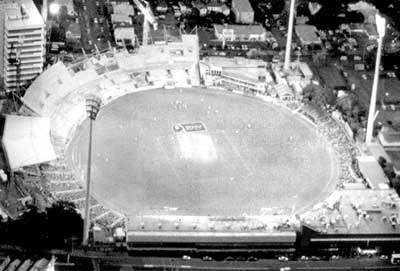
Fast and furious
For the past few weeks, discussions and reports on the Sri Lankan team in Australia has often revolved around the topic of fast bouncy pitches. This is bound to be the case for the next couple of weeks too. Whatever the final outcome of the two test matches, once it is done with the topic will be less discussed or perhaps forgotten. What make pitches fast and bouncy is mainly the characteristics of the top soil. Similarly should it be slow or seaming or turning tracks, again it’s down to the top soil. That is the top four to six inches of the playing surface. This soil is often unearthed from river beds or fields that contain some amount of moisture and water during periods of rain.Above all it is the clay content that determines pace and bounce. The higher the clay content, the harder the pitch becomes and that naturally gets the ball to go through quickly and bounce higher. It is therefore a varying factor from country to country.Australia and South Africa have the fastest and bounciest pitches in the world, in general. The clay content on most pitches in these two countries are seventy percent more. Most tracks in other parts of the world have a lesser percentage of clay on their top soil. India and England have about fifty percent of clay in their soil. In England it is referred to as loam, in most other parts as top soil and strangely as dirt in Australia! Pitches that are high on clay often open up as a game progresses. This is as a result of the moisture escaping though the rigid particles. It is often the case with surfaces in Brisbane and Perth. In Perth the cracks widen to such an extent that a bat could be stuck in and balanced, on the fifth day of a game! This explains the nature of tracks around the world. It tells us why some pitches are so good for batting, while some spin, some seam around. The amount of grass, the moisture in the surface and humid, overcast conditions aids seam and swing bowling. England and parts of New Zealand, particularly during late spring often give the seam bowlers a distinct advantage. The clay content of top soil in Sri Lanka is around sixty to sixty five percent. This borders on pitches being quick and bouncy. The older pitches at the S.S.C., P. Sara Stadium, C.C.C. and Colts C.C. which have around six inches of the “Pot Clay” mix, can produce fast, bouncy tracks. The preparation has much to do with the outcome. A factor that also aids in quickening the pitch is the weight of the roller. All major grounds will have three rollers. The heavy roller, the medium weight roller and the light roller. For early preparation and when the surface contains a high amount of moisture, the light and medium rollers are used. The use of the heavy roller then determines how hard the pitch will finally turn out to be. A heavy roller must weigh between two and three tons. Most rollers of this weight are now mechanized. There are machines that can be guided by hand, enabling one person to steer it. The sit-on type which is the more expensive is now becoming more and more popular. Manually, four to five people are required to push a heavy roller. Grounds that do not have that many staff in this country struggle to apply a heavy roller in preparation. Often players get involved when they come to practice in the evening. But then, that may not be the correct time as most of the moisture would have dried and the soil would not bind together. On to the test pitch at the “Gabba” in Brisbane. It looked well prepared and in fact the entire square and outfield looked in great shape, considering the ground is coming out of winter, where it takes a beating from Aussie Rules Football. One of the commentators mentioned that the track was perfectly flat. Also, the grass was evenly distributed. That is what players want to see – not a patchy surface. Theoretically, an ideal test match pitch should have pace and bounce on day one to assist the quicker bowlers. Then ease out to give batsmen the opportunity from mid day two to day three. Then as the game proceeds into day four and five the spinners come into the game to provide an interesting finish. That is a “test” match, where all the skills in the game are produced in the one encounter over five days. That rarely happens, partly because it is very difficult to prepare such a pitch and partly because top players now perform their skills on whatever surface. Muttiah Muralitharan was spinning the ball and was the most difficult bowler for the Australians to play day one of the match. Perhaps the Brisbane pitch was not as quick and bouncy as some of the pitches produced for the first test of the Australian summer. Then, Sri Lanka left out Lasith Malinga, for Fervez Mahroof. Mahroof is the more accurate of the two and did have a good game against Queensland in the run up to the first test match. In the final analysis, the longer version of the game must be played on fast bouncy pitches whenever possible. It brings out the best of the players. |
|| Front
Page | News | Editorial | Columns | Sports | Plus | Financial
Times | International | Mirror | TV
Times | Funday
Times || |
| |
Reproduction of articles permitted when used without any alterations to contents and the source. |
© Copyright
2007 | Wijeya
Newspapers Ltd.Colombo. Sri Lanka. All Rights Reserved. |
